Organisational Behaviour Report: A David & Co Analysis and Insights
VerifiedAdded on 2020/10/05
|15
|4635
|376
Report
AI Summary
This report provides an in-depth analysis of organisational behaviour within the context of A David & Co Limited, a food and beverage company. It examines the influence of organisational culture, politics, and power on individual and team performance, with a focus on Charles Handy's typology and its impact. The report further explores motivational theories, specifically content theories such as Herzberg's two-factor theory, and how these theories can be applied to enhance employee motivation and achieve organisational goals. The discussion also covers the concept of effective teams, contrasting them with ineffective teams, and delves into the philosophies of organisational behaviour within the given situation. The report concludes with a synthesis of the key findings and their implications for organisational success, offering valuable insights into managing human behaviour in the workplace.
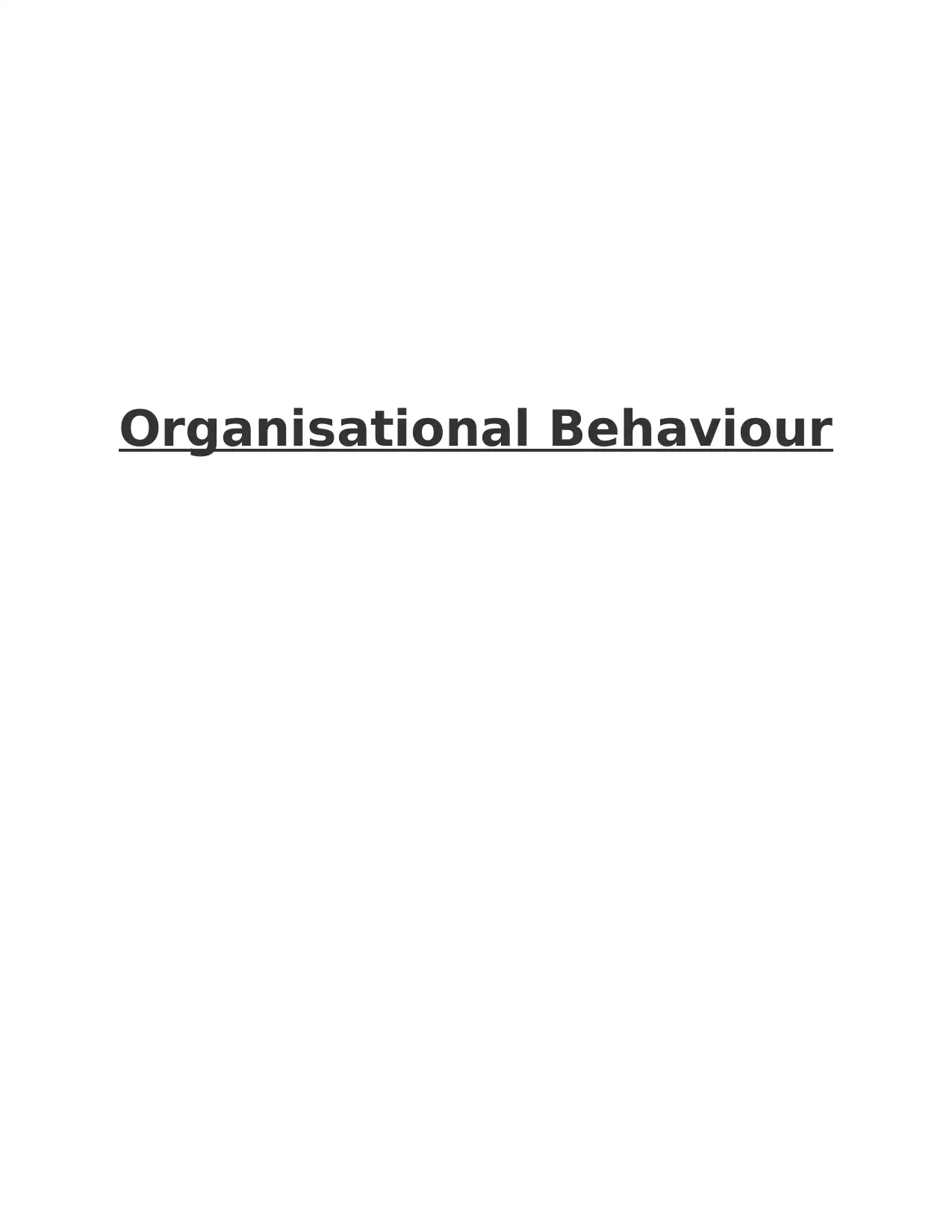
Organisational Behaviour
Paraphrase This Document
Need a fresh take? Get an instant paraphrase of this document with our AI Paraphraser
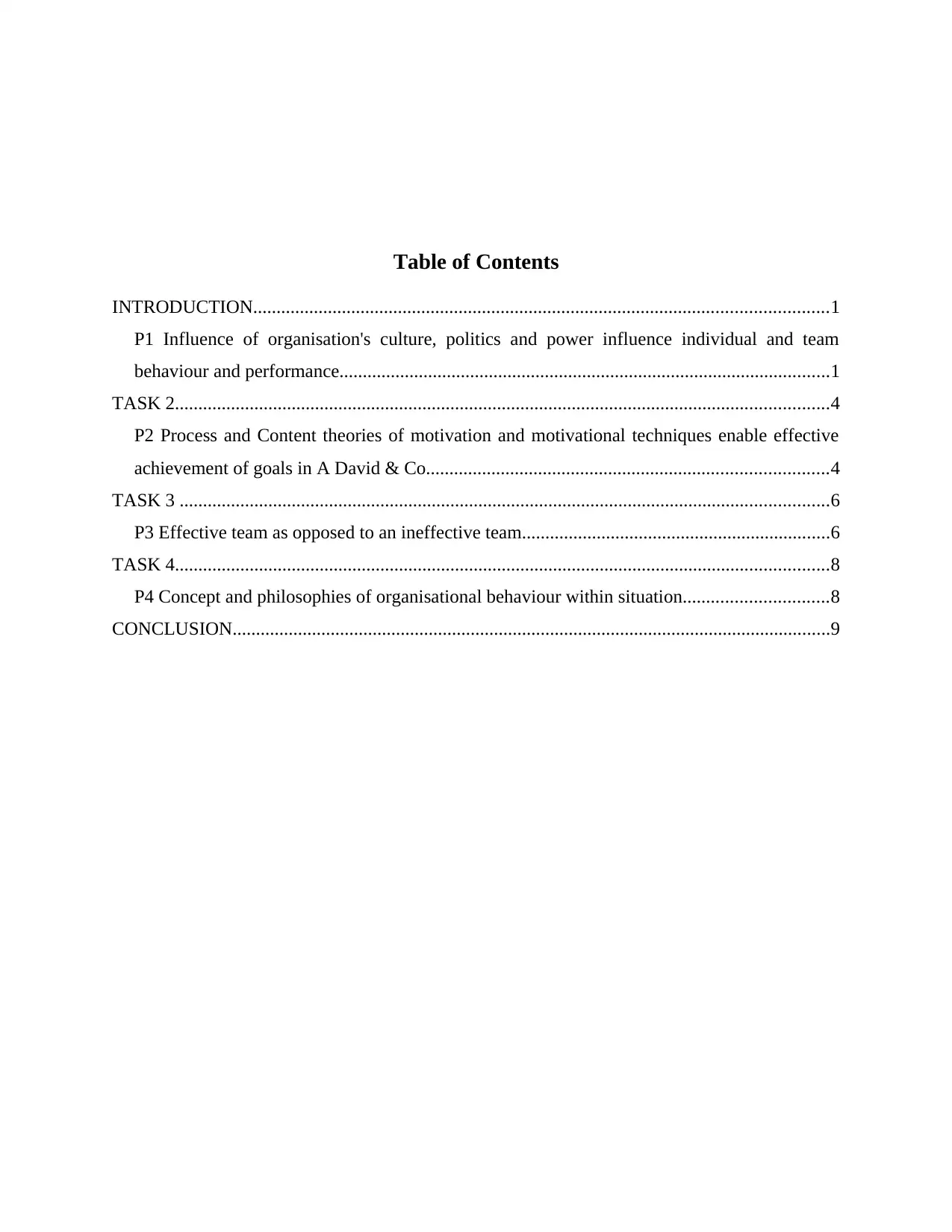
Table of Contents
INTRODUCTION...........................................................................................................................1
P1 Influence of organisation's culture, politics and power influence individual and team
behaviour and performance.........................................................................................................1
TASK 2............................................................................................................................................4
P2 Process and Content theories of motivation and motivational techniques enable effective
achievement of goals in A David & Co......................................................................................4
TASK 3 ...........................................................................................................................................6
P3 Effective team as opposed to an ineffective team..................................................................6
TASK 4............................................................................................................................................8
P4 Concept and philosophies of organisational behaviour within situation...............................8
CONCLUSION................................................................................................................................9
INTRODUCTION...........................................................................................................................1
P1 Influence of organisation's culture, politics and power influence individual and team
behaviour and performance.........................................................................................................1
TASK 2............................................................................................................................................4
P2 Process and Content theories of motivation and motivational techniques enable effective
achievement of goals in A David & Co......................................................................................4
TASK 3 ...........................................................................................................................................6
P3 Effective team as opposed to an ineffective team..................................................................6
TASK 4............................................................................................................................................8
P4 Concept and philosophies of organisational behaviour within situation...............................8
CONCLUSION................................................................................................................................9
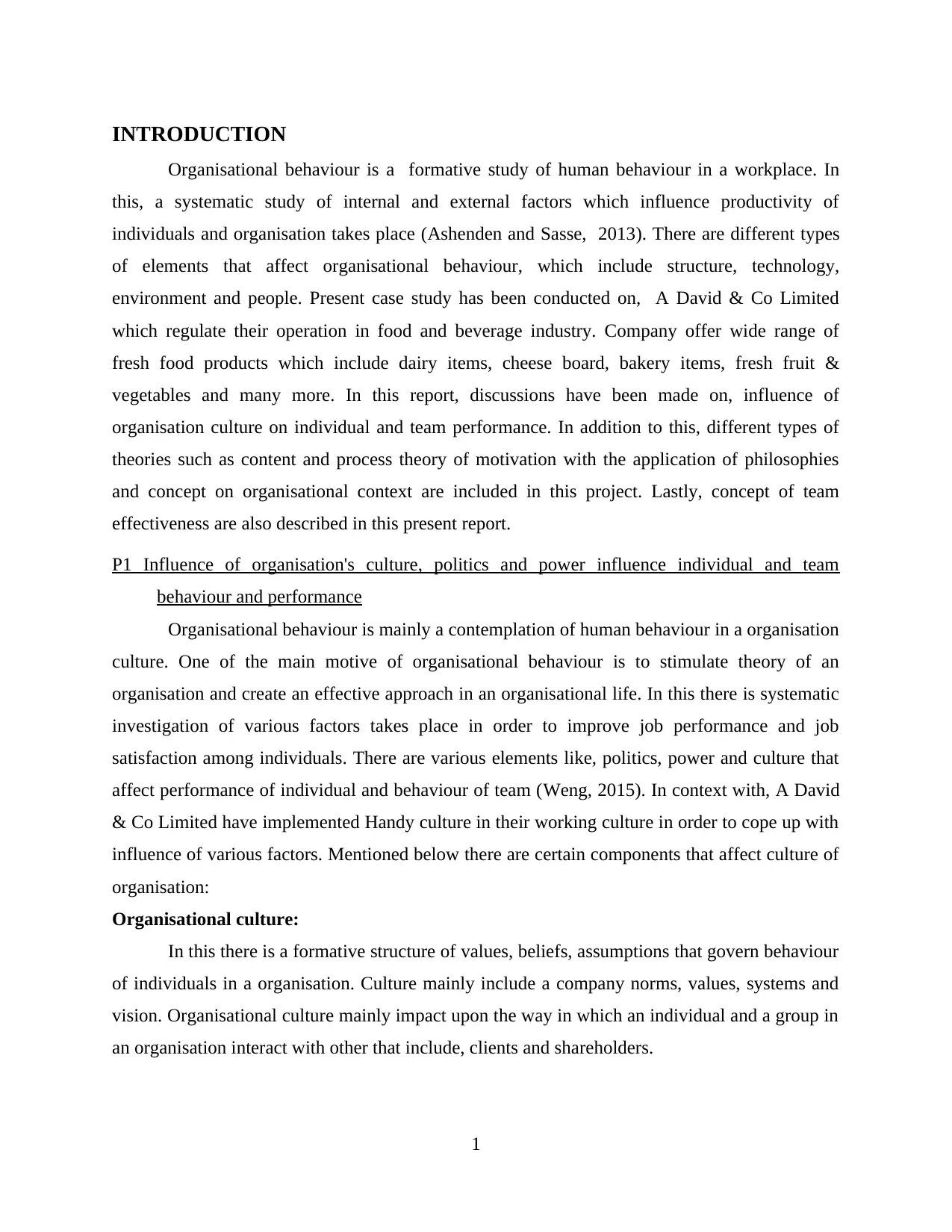
INTRODUCTION
Organisational behaviour is a formative study of human behaviour in a workplace. In
this, a systematic study of internal and external factors which influence productivity of
individuals and organisation takes place (Ashenden and Sasse, 2013). There are different types
of elements that affect organisational behaviour, which include structure, technology,
environment and people. Present case study has been conducted on, A David & Co Limited
which regulate their operation in food and beverage industry. Company offer wide range of
fresh food products which include dairy items, cheese board, bakery items, fresh fruit &
vegetables and many more. In this report, discussions have been made on, influence of
organisation culture on individual and team performance. In addition to this, different types of
theories such as content and process theory of motivation with the application of philosophies
and concept on organisational context are included in this project. Lastly, concept of team
effectiveness are also described in this present report.
P1 Influence of organisation's culture, politics and power influence individual and team
behaviour and performance
Organisational behaviour is mainly a contemplation of human behaviour in a organisation
culture. One of the main motive of organisational behaviour is to stimulate theory of an
organisation and create an effective approach in an organisational life. In this there is systematic
investigation of various factors takes place in order to improve job performance and job
satisfaction among individuals. There are various elements like, politics, power and culture that
affect performance of individual and behaviour of team (Weng, 2015). In context with, A David
& Co Limited have implemented Handy culture in their working culture in order to cope up with
influence of various factors. Mentioned below there are certain components that affect culture of
organisation:
Organisational culture:
In this there is a formative structure of values, beliefs, assumptions that govern behaviour
of individuals in a organisation. Culture mainly include a company norms, values, systems and
vision. Organisational culture mainly impact upon the way in which an individual and a group in
an organisation interact with other that include, clients and shareholders.
1
Organisational behaviour is a formative study of human behaviour in a workplace. In
this, a systematic study of internal and external factors which influence productivity of
individuals and organisation takes place (Ashenden and Sasse, 2013). There are different types
of elements that affect organisational behaviour, which include structure, technology,
environment and people. Present case study has been conducted on, A David & Co Limited
which regulate their operation in food and beverage industry. Company offer wide range of
fresh food products which include dairy items, cheese board, bakery items, fresh fruit &
vegetables and many more. In this report, discussions have been made on, influence of
organisation culture on individual and team performance. In addition to this, different types of
theories such as content and process theory of motivation with the application of philosophies
and concept on organisational context are included in this project. Lastly, concept of team
effectiveness are also described in this present report.
P1 Influence of organisation's culture, politics and power influence individual and team
behaviour and performance
Organisational behaviour is mainly a contemplation of human behaviour in a organisation
culture. One of the main motive of organisational behaviour is to stimulate theory of an
organisation and create an effective approach in an organisational life. In this there is systematic
investigation of various factors takes place in order to improve job performance and job
satisfaction among individuals. There are various elements like, politics, power and culture that
affect performance of individual and behaviour of team (Weng, 2015). In context with, A David
& Co Limited have implemented Handy culture in their working culture in order to cope up with
influence of various factors. Mentioned below there are certain components that affect culture of
organisation:
Organisational culture:
In this there is a formative structure of values, beliefs, assumptions that govern behaviour
of individuals in a organisation. Culture mainly include a company norms, values, systems and
vision. Organisational culture mainly impact upon the way in which an individual and a group in
an organisation interact with other that include, clients and shareholders.
1
⊘ This is a preview!⊘
Do you want full access?
Subscribe today to unlock all pages.

Trusted by 1+ million students worldwide
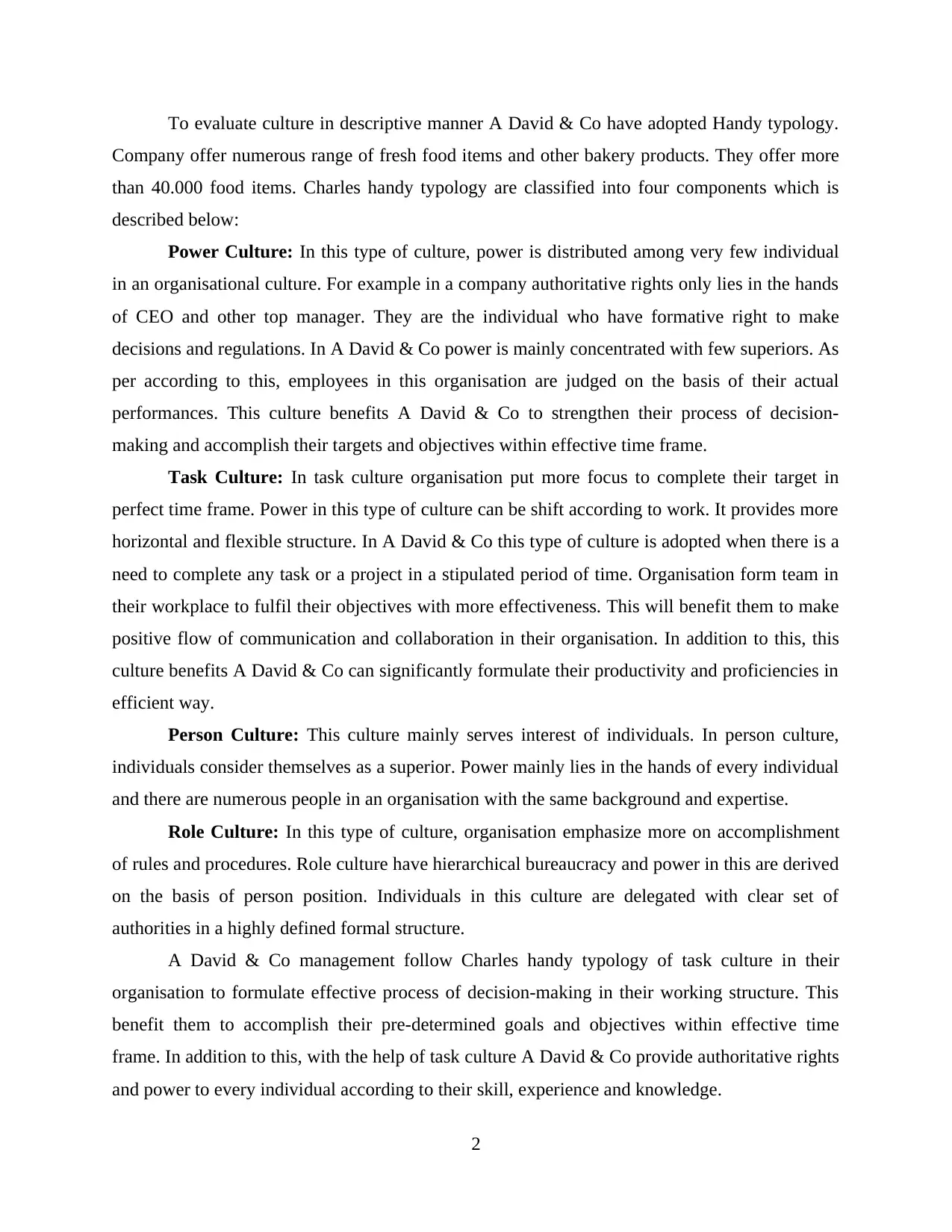
To evaluate culture in descriptive manner A David & Co have adopted Handy typology.
Company offer numerous range of fresh food items and other bakery products. They offer more
than 40.000 food items. Charles handy typology are classified into four components which is
described below:
Power Culture: In this type of culture, power is distributed among very few individual
in an organisational culture. For example in a company authoritative rights only lies in the hands
of CEO and other top manager. They are the individual who have formative right to make
decisions and regulations. In A David & Co power is mainly concentrated with few superiors. As
per according to this, employees in this organisation are judged on the basis of their actual
performances. This culture benefits A David & Co to strengthen their process of decision-
making and accomplish their targets and objectives within effective time frame.
Task Culture: In task culture organisation put more focus to complete their target in
perfect time frame. Power in this type of culture can be shift according to work. It provides more
horizontal and flexible structure. In A David & Co this type of culture is adopted when there is a
need to complete any task or a project in a stipulated period of time. Organisation form team in
their workplace to fulfil their objectives with more effectiveness. This will benefit them to make
positive flow of communication and collaboration in their organisation. In addition to this, this
culture benefits A David & Co can significantly formulate their productivity and proficiencies in
efficient way.
Person Culture: This culture mainly serves interest of individuals. In person culture,
individuals consider themselves as a superior. Power mainly lies in the hands of every individual
and there are numerous people in an organisation with the same background and expertise.
Role Culture: In this type of culture, organisation emphasize more on accomplishment
of rules and procedures. Role culture have hierarchical bureaucracy and power in this are derived
on the basis of person position. Individuals in this culture are delegated with clear set of
authorities in a highly defined formal structure.
A David & Co management follow Charles handy typology of task culture in their
organisation to formulate effective process of decision-making in their working structure. This
benefit them to accomplish their pre-determined goals and objectives within effective time
frame. In addition to this, with the help of task culture A David & Co provide authoritative rights
and power to every individual according to their skill, experience and knowledge.
2
Company offer numerous range of fresh food items and other bakery products. They offer more
than 40.000 food items. Charles handy typology are classified into four components which is
described below:
Power Culture: In this type of culture, power is distributed among very few individual
in an organisational culture. For example in a company authoritative rights only lies in the hands
of CEO and other top manager. They are the individual who have formative right to make
decisions and regulations. In A David & Co power is mainly concentrated with few superiors. As
per according to this, employees in this organisation are judged on the basis of their actual
performances. This culture benefits A David & Co to strengthen their process of decision-
making and accomplish their targets and objectives within effective time frame.
Task Culture: In task culture organisation put more focus to complete their target in
perfect time frame. Power in this type of culture can be shift according to work. It provides more
horizontal and flexible structure. In A David & Co this type of culture is adopted when there is a
need to complete any task or a project in a stipulated period of time. Organisation form team in
their workplace to fulfil their objectives with more effectiveness. This will benefit them to make
positive flow of communication and collaboration in their organisation. In addition to this, this
culture benefits A David & Co can significantly formulate their productivity and proficiencies in
efficient way.
Person Culture: This culture mainly serves interest of individuals. In person culture,
individuals consider themselves as a superior. Power mainly lies in the hands of every individual
and there are numerous people in an organisation with the same background and expertise.
Role Culture: In this type of culture, organisation emphasize more on accomplishment
of rules and procedures. Role culture have hierarchical bureaucracy and power in this are derived
on the basis of person position. Individuals in this culture are delegated with clear set of
authorities in a highly defined formal structure.
A David & Co management follow Charles handy typology of task culture in their
organisation to formulate effective process of decision-making in their working structure. This
benefit them to accomplish their pre-determined goals and objectives within effective time
frame. In addition to this, with the help of task culture A David & Co provide authoritative rights
and power to every individual according to their skill, experience and knowledge.
2
Paraphrase This Document
Need a fresh take? Get an instant paraphrase of this document with our AI Paraphraser
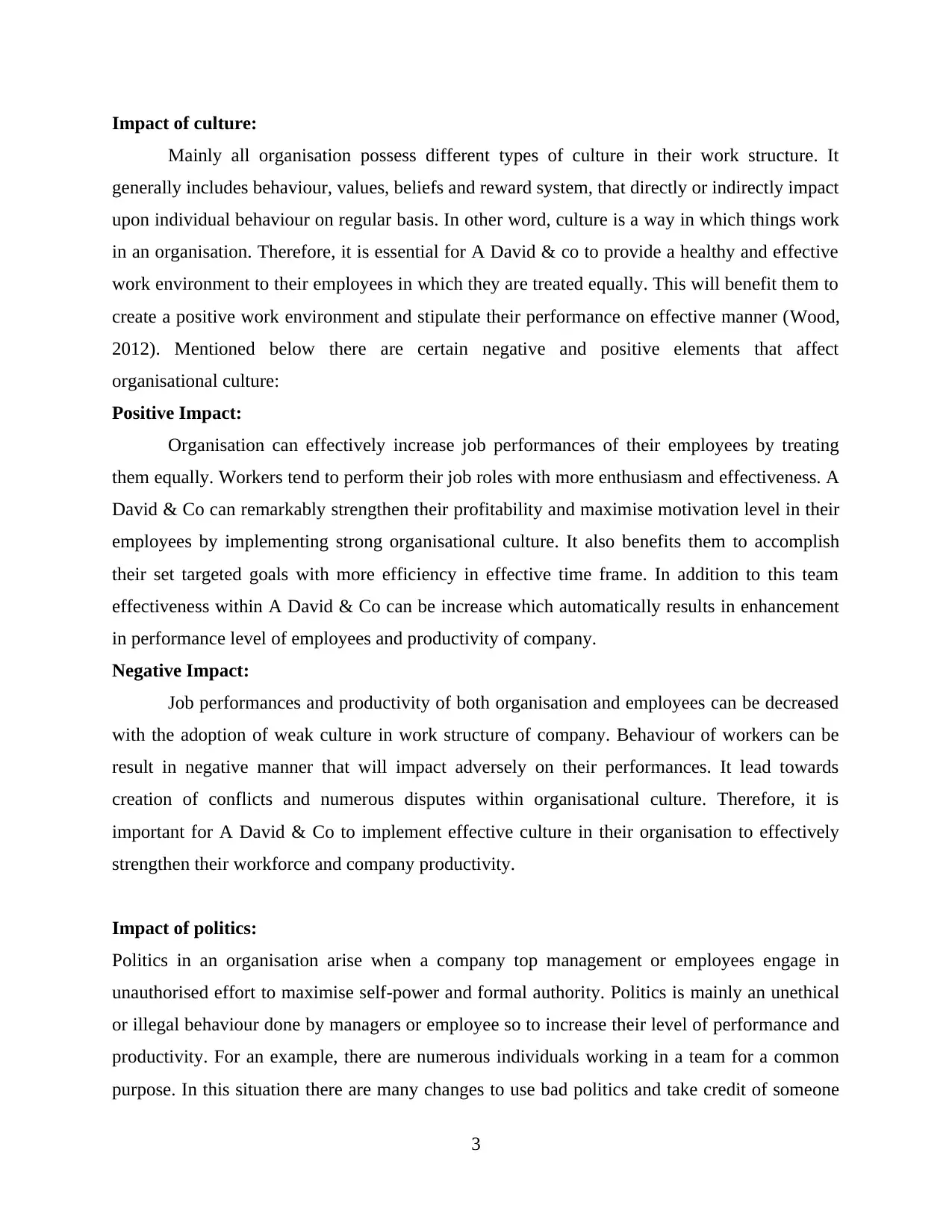
Impact of culture:
Mainly all organisation possess different types of culture in their work structure. It
generally includes behaviour, values, beliefs and reward system, that directly or indirectly impact
upon individual behaviour on regular basis. In other word, culture is a way in which things work
in an organisation. Therefore, it is essential for A David & co to provide a healthy and effective
work environment to their employees in which they are treated equally. This will benefit them to
create a positive work environment and stipulate their performance on effective manner (Wood,
2012). Mentioned below there are certain negative and positive elements that affect
organisational culture:
Positive Impact:
Organisation can effectively increase job performances of their employees by treating
them equally. Workers tend to perform their job roles with more enthusiasm and effectiveness. A
David & Co can remarkably strengthen their profitability and maximise motivation level in their
employees by implementing strong organisational culture. It also benefits them to accomplish
their set targeted goals with more efficiency in effective time frame. In addition to this team
effectiveness within A David & Co can be increase which automatically results in enhancement
in performance level of employees and productivity of company.
Negative Impact:
Job performances and productivity of both organisation and employees can be decreased
with the adoption of weak culture in work structure of company. Behaviour of workers can be
result in negative manner that will impact adversely on their performances. It lead towards
creation of conflicts and numerous disputes within organisational culture. Therefore, it is
important for A David & Co to implement effective culture in their organisation to effectively
strengthen their workforce and company productivity.
Impact of politics:
Politics in an organisation arise when a company top management or employees engage in
unauthorised effort to maximise self-power and formal authority. Politics is mainly an unethical
or illegal behaviour done by managers or employee so to increase their level of performance and
productivity. For an example, there are numerous individuals working in a team for a common
purpose. In this situation there are many changes to use bad politics and take credit of someone
3
Mainly all organisation possess different types of culture in their work structure. It
generally includes behaviour, values, beliefs and reward system, that directly or indirectly impact
upon individual behaviour on regular basis. In other word, culture is a way in which things work
in an organisation. Therefore, it is essential for A David & co to provide a healthy and effective
work environment to their employees in which they are treated equally. This will benefit them to
create a positive work environment and stipulate their performance on effective manner (Wood,
2012). Mentioned below there are certain negative and positive elements that affect
organisational culture:
Positive Impact:
Organisation can effectively increase job performances of their employees by treating
them equally. Workers tend to perform their job roles with more enthusiasm and effectiveness. A
David & Co can remarkably strengthen their profitability and maximise motivation level in their
employees by implementing strong organisational culture. It also benefits them to accomplish
their set targeted goals with more efficiency in effective time frame. In addition to this team
effectiveness within A David & Co can be increase which automatically results in enhancement
in performance level of employees and productivity of company.
Negative Impact:
Job performances and productivity of both organisation and employees can be decreased
with the adoption of weak culture in work structure of company. Behaviour of workers can be
result in negative manner that will impact adversely on their performances. It lead towards
creation of conflicts and numerous disputes within organisational culture. Therefore, it is
important for A David & Co to implement effective culture in their organisation to effectively
strengthen their workforce and company productivity.
Impact of politics:
Politics in an organisation arise when a company top management or employees engage in
unauthorised effort to maximise self-power and formal authority. Politics is mainly an unethical
or illegal behaviour done by managers or employee so to increase their level of performance and
productivity. For an example, there are numerous individuals working in a team for a common
purpose. In this situation there are many changes to use bad politics and take credit of someone
3
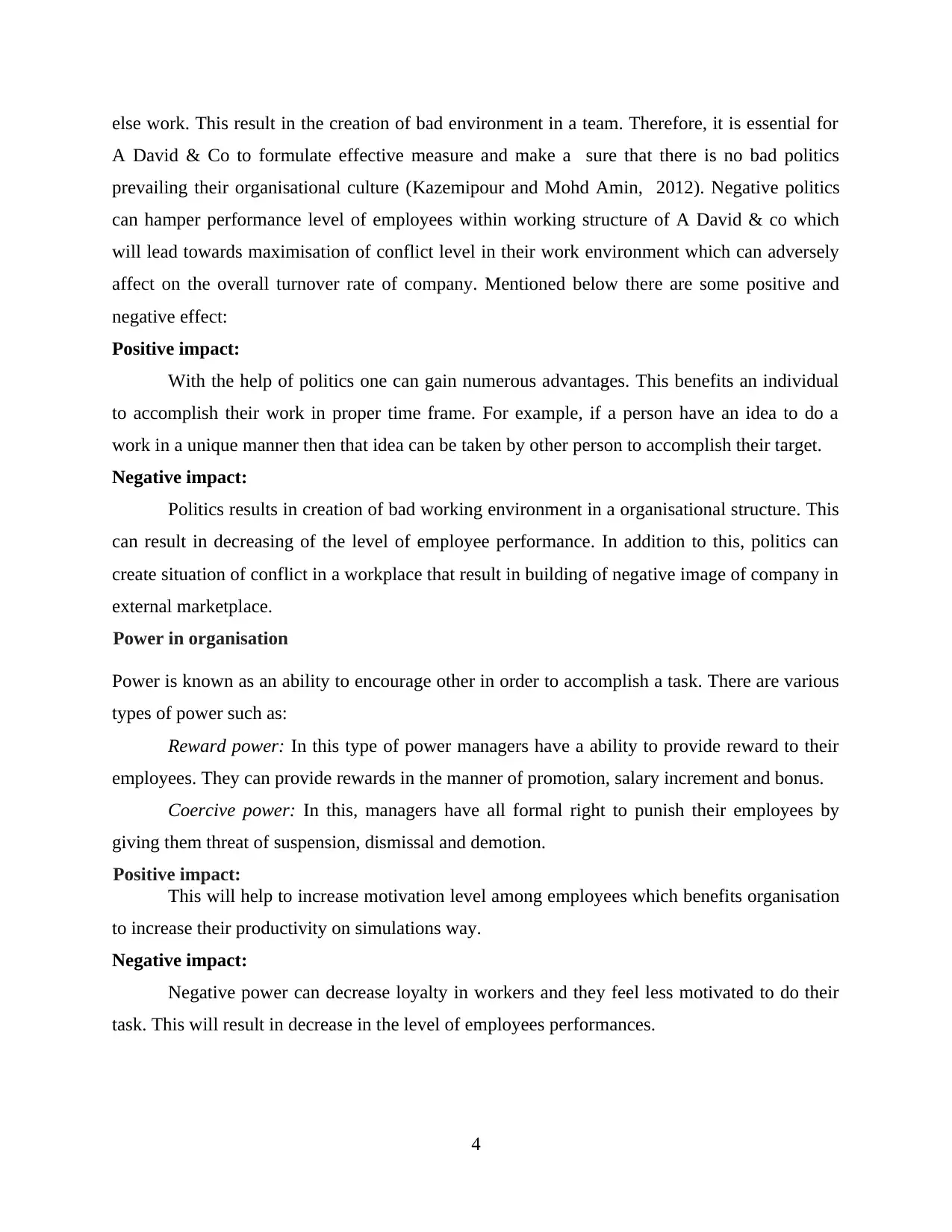
else work. This result in the creation of bad environment in a team. Therefore, it is essential for
A David & Co to formulate effective measure and make a sure that there is no bad politics
prevailing their organisational culture (Kazemipour and Mohd Amin, 2012). Negative politics
can hamper performance level of employees within working structure of A David & co which
will lead towards maximisation of conflict level in their work environment which can adversely
affect on the overall turnover rate of company. Mentioned below there are some positive and
negative effect:
Positive impact:
With the help of politics one can gain numerous advantages. This benefits an individual
to accomplish their work in proper time frame. For example, if a person have an idea to do a
work in a unique manner then that idea can be taken by other person to accomplish their target.
Negative impact:
Politics results in creation of bad working environment in a organisational structure. This
can result in decreasing of the level of employee performance. In addition to this, politics can
create situation of conflict in a workplace that result in building of negative image of company in
external marketplace.
Power in organisation
Power is known as an ability to encourage other in order to accomplish a task. There are various
types of power such as:
Reward power: In this type of power managers have a ability to provide reward to their
employees. They can provide rewards in the manner of promotion, salary increment and bonus.
Coercive power: In this, managers have all formal right to punish their employees by
giving them threat of suspension, dismissal and demotion.
Positive impact:
This will help to increase motivation level among employees which benefits organisation
to increase their productivity on simulations way.
Negative impact:
Negative power can decrease loyalty in workers and they feel less motivated to do their
task. This will result in decrease in the level of employees performances.
4
A David & Co to formulate effective measure and make a sure that there is no bad politics
prevailing their organisational culture (Kazemipour and Mohd Amin, 2012). Negative politics
can hamper performance level of employees within working structure of A David & co which
will lead towards maximisation of conflict level in their work environment which can adversely
affect on the overall turnover rate of company. Mentioned below there are some positive and
negative effect:
Positive impact:
With the help of politics one can gain numerous advantages. This benefits an individual
to accomplish their work in proper time frame. For example, if a person have an idea to do a
work in a unique manner then that idea can be taken by other person to accomplish their target.
Negative impact:
Politics results in creation of bad working environment in a organisational structure. This
can result in decreasing of the level of employee performance. In addition to this, politics can
create situation of conflict in a workplace that result in building of negative image of company in
external marketplace.
Power in organisation
Power is known as an ability to encourage other in order to accomplish a task. There are various
types of power such as:
Reward power: In this type of power managers have a ability to provide reward to their
employees. They can provide rewards in the manner of promotion, salary increment and bonus.
Coercive power: In this, managers have all formal right to punish their employees by
giving them threat of suspension, dismissal and demotion.
Positive impact:
This will help to increase motivation level among employees which benefits organisation
to increase their productivity on simulations way.
Negative impact:
Negative power can decrease loyalty in workers and they feel less motivated to do their
task. This will result in decrease in the level of employees performances.
4
⊘ This is a preview!⊘
Do you want full access?
Subscribe today to unlock all pages.

Trusted by 1+ million students worldwide
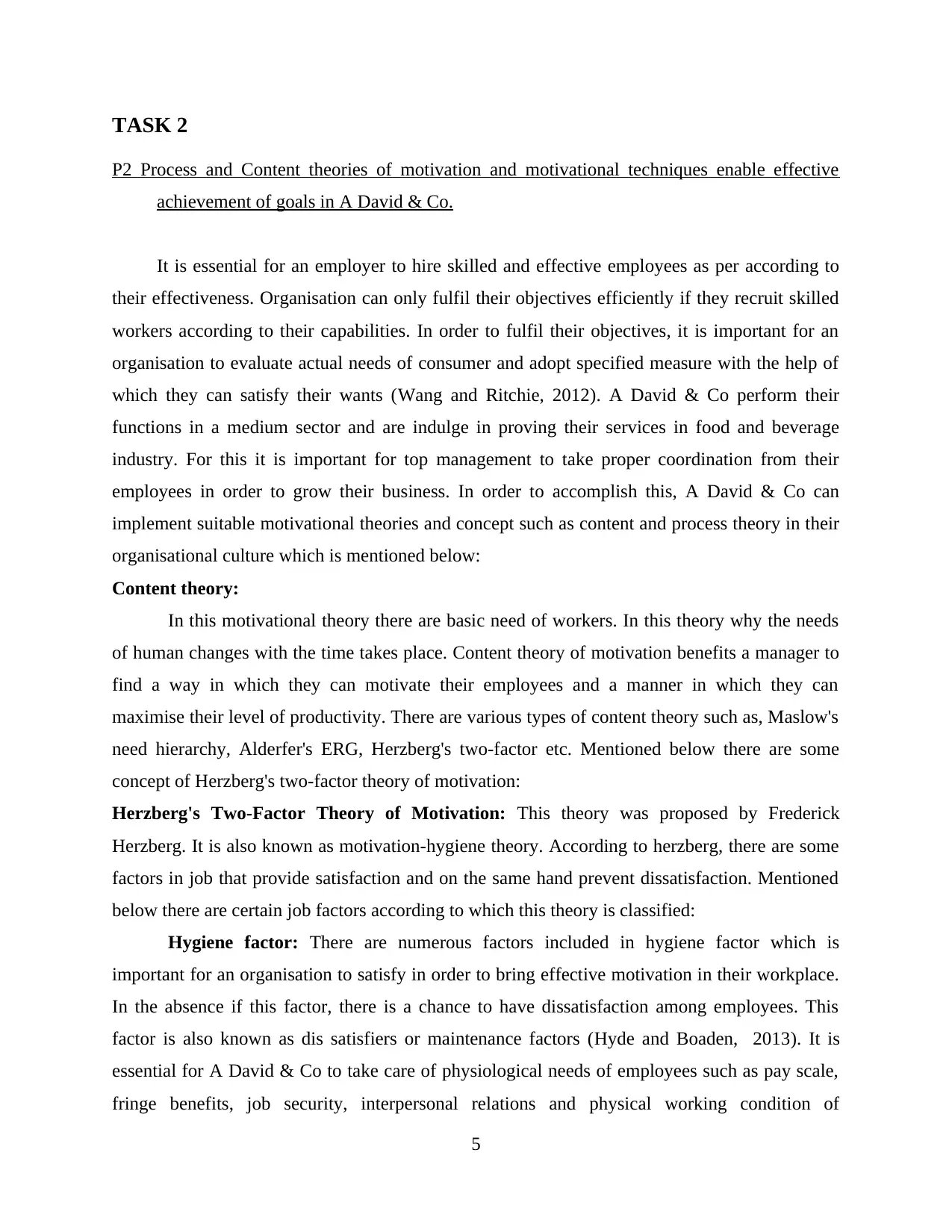
TASK 2
P2 Process and Content theories of motivation and motivational techniques enable effective
achievement of goals in A David & Co.
It is essential for an employer to hire skilled and effective employees as per according to
their effectiveness. Organisation can only fulfil their objectives efficiently if they recruit skilled
workers according to their capabilities. In order to fulfil their objectives, it is important for an
organisation to evaluate actual needs of consumer and adopt specified measure with the help of
which they can satisfy their wants (Wang and Ritchie, 2012). A David & Co perform their
functions in a medium sector and are indulge in proving their services in food and beverage
industry. For this it is important for top management to take proper coordination from their
employees in order to grow their business. In order to accomplish this, A David & Co can
implement suitable motivational theories and concept such as content and process theory in their
organisational culture which is mentioned below:
Content theory:
In this motivational theory there are basic need of workers. In this theory why the needs
of human changes with the time takes place. Content theory of motivation benefits a manager to
find a way in which they can motivate their employees and a manner in which they can
maximise their level of productivity. There are various types of content theory such as, Maslow's
need hierarchy, Alderfer's ERG, Herzberg's two-factor etc. Mentioned below there are some
concept of Herzberg's two-factor theory of motivation:
Herzberg's Two-Factor Theory of Motivation: This theory was proposed by Frederick
Herzberg. It is also known as motivation-hygiene theory. According to herzberg, there are some
factors in job that provide satisfaction and on the same hand prevent dissatisfaction. Mentioned
below there are certain job factors according to which this theory is classified:
Hygiene factor: There are numerous factors included in hygiene factor which is
important for an organisation to satisfy in order to bring effective motivation in their workplace.
In the absence if this factor, there is a chance to have dissatisfaction among employees. This
factor is also known as dis satisfiers or maintenance factors (Hyde and Boaden, 2013). It is
essential for A David & Co to take care of physiological needs of employees such as pay scale,
fringe benefits, job security, interpersonal relations and physical working condition of
5
P2 Process and Content theories of motivation and motivational techniques enable effective
achievement of goals in A David & Co.
It is essential for an employer to hire skilled and effective employees as per according to
their effectiveness. Organisation can only fulfil their objectives efficiently if they recruit skilled
workers according to their capabilities. In order to fulfil their objectives, it is important for an
organisation to evaluate actual needs of consumer and adopt specified measure with the help of
which they can satisfy their wants (Wang and Ritchie, 2012). A David & Co perform their
functions in a medium sector and are indulge in proving their services in food and beverage
industry. For this it is important for top management to take proper coordination from their
employees in order to grow their business. In order to accomplish this, A David & Co can
implement suitable motivational theories and concept such as content and process theory in their
organisational culture which is mentioned below:
Content theory:
In this motivational theory there are basic need of workers. In this theory why the needs
of human changes with the time takes place. Content theory of motivation benefits a manager to
find a way in which they can motivate their employees and a manner in which they can
maximise their level of productivity. There are various types of content theory such as, Maslow's
need hierarchy, Alderfer's ERG, Herzberg's two-factor etc. Mentioned below there are some
concept of Herzberg's two-factor theory of motivation:
Herzberg's Two-Factor Theory of Motivation: This theory was proposed by Frederick
Herzberg. It is also known as motivation-hygiene theory. According to herzberg, there are some
factors in job that provide satisfaction and on the same hand prevent dissatisfaction. Mentioned
below there are certain job factors according to which this theory is classified:
Hygiene factor: There are numerous factors included in hygiene factor which is
important for an organisation to satisfy in order to bring effective motivation in their workplace.
In the absence if this factor, there is a chance to have dissatisfaction among employees. This
factor is also known as dis satisfiers or maintenance factors (Hyde and Boaden, 2013). It is
essential for A David & Co to take care of physiological needs of employees such as pay scale,
fringe benefits, job security, interpersonal relations and physical working condition of
5
Paraphrase This Document
Need a fresh take? Get an instant paraphrase of this document with our AI Paraphraser
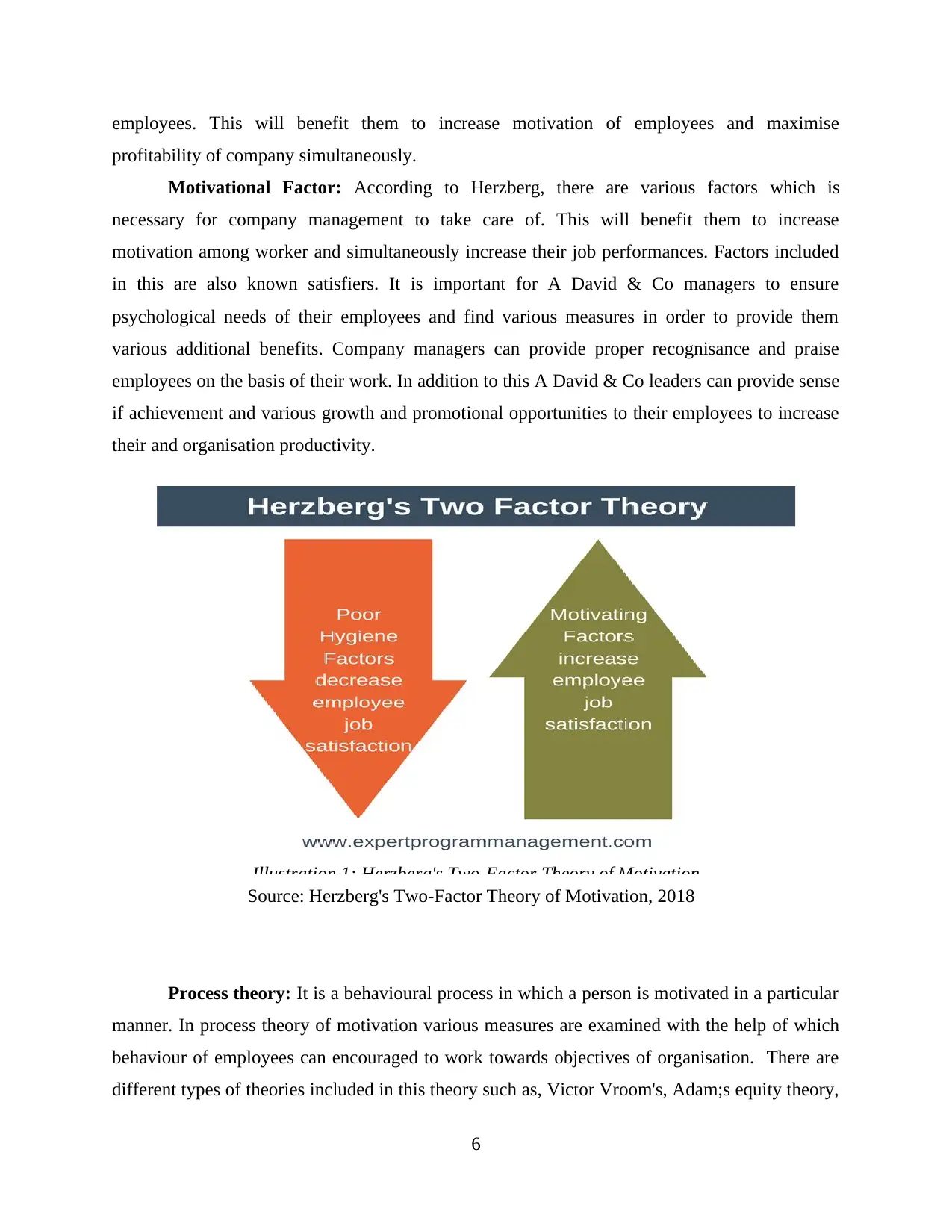
employees. This will benefit them to increase motivation of employees and maximise
profitability of company simultaneously.
Motivational Factor: According to Herzberg, there are various factors which is
necessary for company management to take care of. This will benefit them to increase
motivation among worker and simultaneously increase their job performances. Factors included
in this are also known satisfiers. It is important for A David & Co managers to ensure
psychological needs of their employees and find various measures in order to provide them
various additional benefits. Company managers can provide proper recognisance and praise
employees on the basis of their work. In addition to this A David & Co leaders can provide sense
if achievement and various growth and promotional opportunities to their employees to increase
their and organisation productivity.
Source: Herzberg's Two-Factor Theory of Motivation, 2018
Process theory: It is a behavioural process in which a person is motivated in a particular
manner. In process theory of motivation various measures are examined with the help of which
behaviour of employees can encouraged to work towards objectives of organisation. There are
different types of theories included in this theory such as, Victor Vroom's, Adam;s equity theory,
6
Illustration 1: Herzberg's Two-Factor Theory of Motivation
profitability of company simultaneously.
Motivational Factor: According to Herzberg, there are various factors which is
necessary for company management to take care of. This will benefit them to increase
motivation among worker and simultaneously increase their job performances. Factors included
in this are also known satisfiers. It is important for A David & Co managers to ensure
psychological needs of their employees and find various measures in order to provide them
various additional benefits. Company managers can provide proper recognisance and praise
employees on the basis of their work. In addition to this A David & Co leaders can provide sense
if achievement and various growth and promotional opportunities to their employees to increase
their and organisation productivity.
Source: Herzberg's Two-Factor Theory of Motivation, 2018
Process theory: It is a behavioural process in which a person is motivated in a particular
manner. In process theory of motivation various measures are examined with the help of which
behaviour of employees can encouraged to work towards objectives of organisation. There are
different types of theories included in this theory such as, Victor Vroom's, Adam;s equity theory,
6
Illustration 1: Herzberg's Two-Factor Theory of Motivation
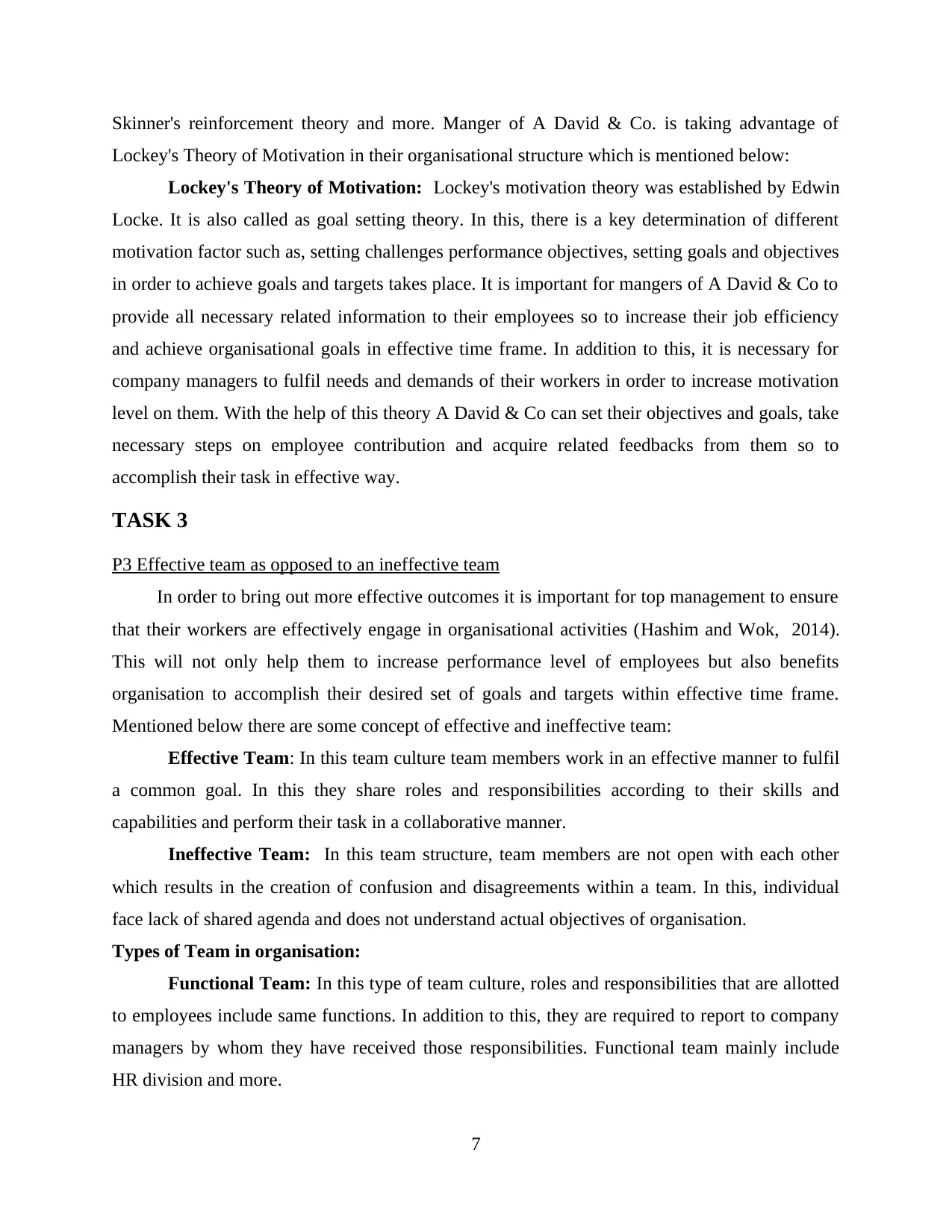
Skinner's reinforcement theory and more. Manger of A David & Co. is taking advantage of
Lockey's Theory of Motivation in their organisational structure which is mentioned below:
Lockey's Theory of Motivation: Lockey's motivation theory was established by Edwin
Locke. It is also called as goal setting theory. In this, there is a key determination of different
motivation factor such as, setting challenges performance objectives, setting goals and objectives
in order to achieve goals and targets takes place. It is important for mangers of A David & Co to
provide all necessary related information to their employees so to increase their job efficiency
and achieve organisational goals in effective time frame. In addition to this, it is necessary for
company managers to fulfil needs and demands of their workers in order to increase motivation
level on them. With the help of this theory A David & Co can set their objectives and goals, take
necessary steps on employee contribution and acquire related feedbacks from them so to
accomplish their task in effective way.
TASK 3
P3 Effective team as opposed to an ineffective team
In order to bring out more effective outcomes it is important for top management to ensure
that their workers are effectively engage in organisational activities (Hashim and Wok, 2014).
This will not only help them to increase performance level of employees but also benefits
organisation to accomplish their desired set of goals and targets within effective time frame.
Mentioned below there are some concept of effective and ineffective team:
Effective Team: In this team culture team members work in an effective manner to fulfil
a common goal. In this they share roles and responsibilities according to their skills and
capabilities and perform their task in a collaborative manner.
Ineffective Team: In this team structure, team members are not open with each other
which results in the creation of confusion and disagreements within a team. In this, individual
face lack of shared agenda and does not understand actual objectives of organisation.
Types of Team in organisation:
Functional Team: In this type of team culture, roles and responsibilities that are allotted
to employees include same functions. In addition to this, they are required to report to company
managers by whom they have received those responsibilities. Functional team mainly include
HR division and more.
7
Lockey's Theory of Motivation in their organisational structure which is mentioned below:
Lockey's Theory of Motivation: Lockey's motivation theory was established by Edwin
Locke. It is also called as goal setting theory. In this, there is a key determination of different
motivation factor such as, setting challenges performance objectives, setting goals and objectives
in order to achieve goals and targets takes place. It is important for mangers of A David & Co to
provide all necessary related information to their employees so to increase their job efficiency
and achieve organisational goals in effective time frame. In addition to this, it is necessary for
company managers to fulfil needs and demands of their workers in order to increase motivation
level on them. With the help of this theory A David & Co can set their objectives and goals, take
necessary steps on employee contribution and acquire related feedbacks from them so to
accomplish their task in effective way.
TASK 3
P3 Effective team as opposed to an ineffective team
In order to bring out more effective outcomes it is important for top management to ensure
that their workers are effectively engage in organisational activities (Hashim and Wok, 2014).
This will not only help them to increase performance level of employees but also benefits
organisation to accomplish their desired set of goals and targets within effective time frame.
Mentioned below there are some concept of effective and ineffective team:
Effective Team: In this team culture team members work in an effective manner to fulfil
a common goal. In this they share roles and responsibilities according to their skills and
capabilities and perform their task in a collaborative manner.
Ineffective Team: In this team structure, team members are not open with each other
which results in the creation of confusion and disagreements within a team. In this, individual
face lack of shared agenda and does not understand actual objectives of organisation.
Types of Team in organisation:
Functional Team: In this type of team culture, roles and responsibilities that are allotted
to employees include same functions. In addition to this, they are required to report to company
managers by whom they have received those responsibilities. Functional team mainly include
HR division and more.
7
⊘ This is a preview!⊘
Do you want full access?
Subscribe today to unlock all pages.

Trusted by 1+ million students worldwide
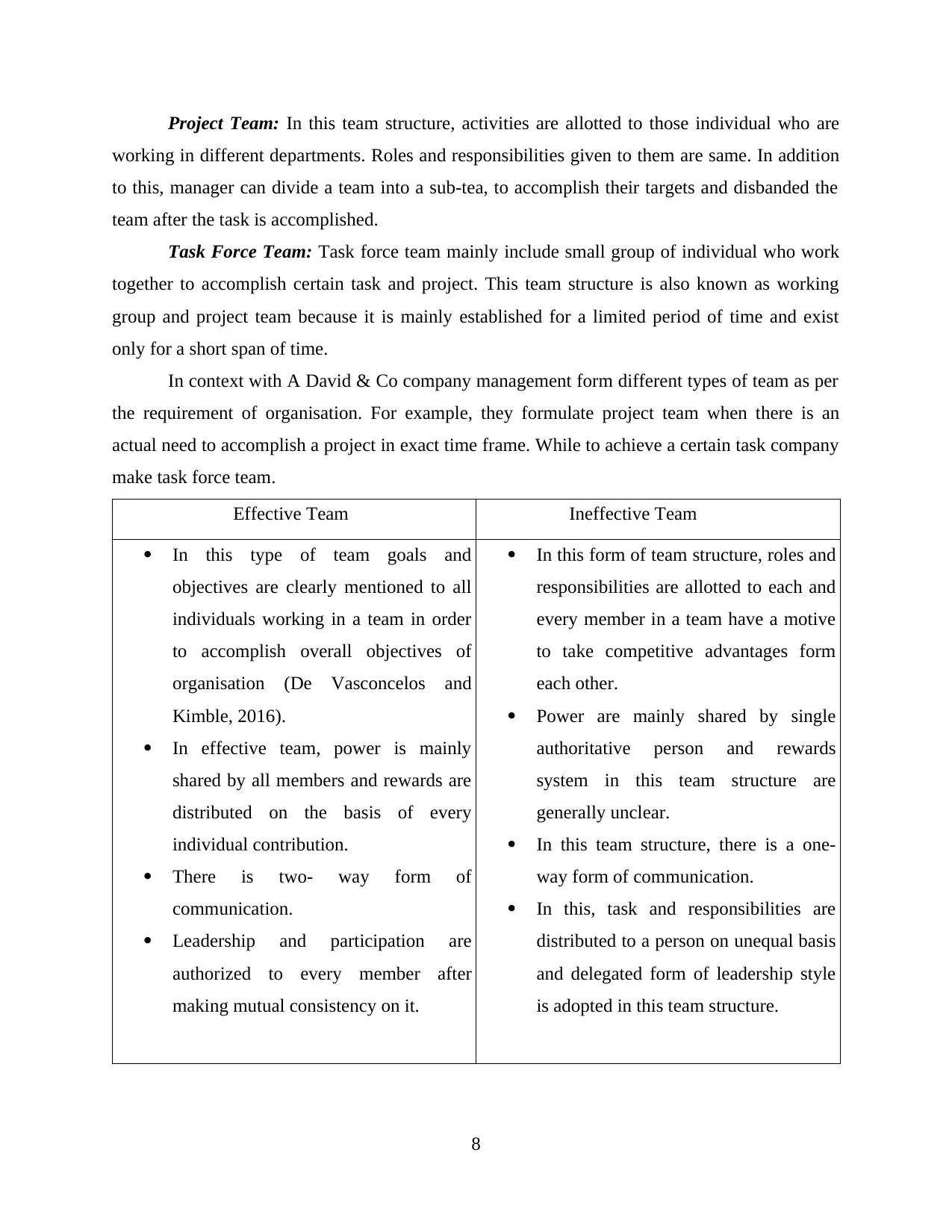
Project Team: In this team structure, activities are allotted to those individual who are
working in different departments. Roles and responsibilities given to them are same. In addition
to this, manager can divide a team into a sub-tea, to accomplish their targets and disbanded the
team after the task is accomplished.
Task Force Team: Task force team mainly include small group of individual who work
together to accomplish certain task and project. This team structure is also known as working
group and project team because it is mainly established for a limited period of time and exist
only for a short span of time.
In context with A David & Co company management form different types of team as per
the requirement of organisation. For example, they formulate project team when there is an
actual need to accomplish a project in exact time frame. While to achieve a certain task company
make task force team.
Effective Team Ineffective Team
In this type of team goals and
objectives are clearly mentioned to all
individuals working in a team in order
to accomplish overall objectives of
organisation (De Vasconcelos and
Kimble, 2016).
In effective team, power is mainly
shared by all members and rewards are
distributed on the basis of every
individual contribution.
There is two- way form of
communication.
Leadership and participation are
authorized to every member after
making mutual consistency on it.
In this form of team structure, roles and
responsibilities are allotted to each and
every member in a team have a motive
to take competitive advantages form
each other.
Power are mainly shared by single
authoritative person and rewards
system in this team structure are
generally unclear.
In this team structure, there is a one-
way form of communication.
In this, task and responsibilities are
distributed to a person on unequal basis
and delegated form of leadership style
is adopted in this team structure.
8
working in different departments. Roles and responsibilities given to them are same. In addition
to this, manager can divide a team into a sub-tea, to accomplish their targets and disbanded the
team after the task is accomplished.
Task Force Team: Task force team mainly include small group of individual who work
together to accomplish certain task and project. This team structure is also known as working
group and project team because it is mainly established for a limited period of time and exist
only for a short span of time.
In context with A David & Co company management form different types of team as per
the requirement of organisation. For example, they formulate project team when there is an
actual need to accomplish a project in exact time frame. While to achieve a certain task company
make task force team.
Effective Team Ineffective Team
In this type of team goals and
objectives are clearly mentioned to all
individuals working in a team in order
to accomplish overall objectives of
organisation (De Vasconcelos and
Kimble, 2016).
In effective team, power is mainly
shared by all members and rewards are
distributed on the basis of every
individual contribution.
There is two- way form of
communication.
Leadership and participation are
authorized to every member after
making mutual consistency on it.
In this form of team structure, roles and
responsibilities are allotted to each and
every member in a team have a motive
to take competitive advantages form
each other.
Power are mainly shared by single
authoritative person and rewards
system in this team structure are
generally unclear.
In this team structure, there is a one-
way form of communication.
In this, task and responsibilities are
distributed to a person on unequal basis
and delegated form of leadership style
is adopted in this team structure.
8
Paraphrase This Document
Need a fresh take? Get an instant paraphrase of this document with our AI Paraphraser
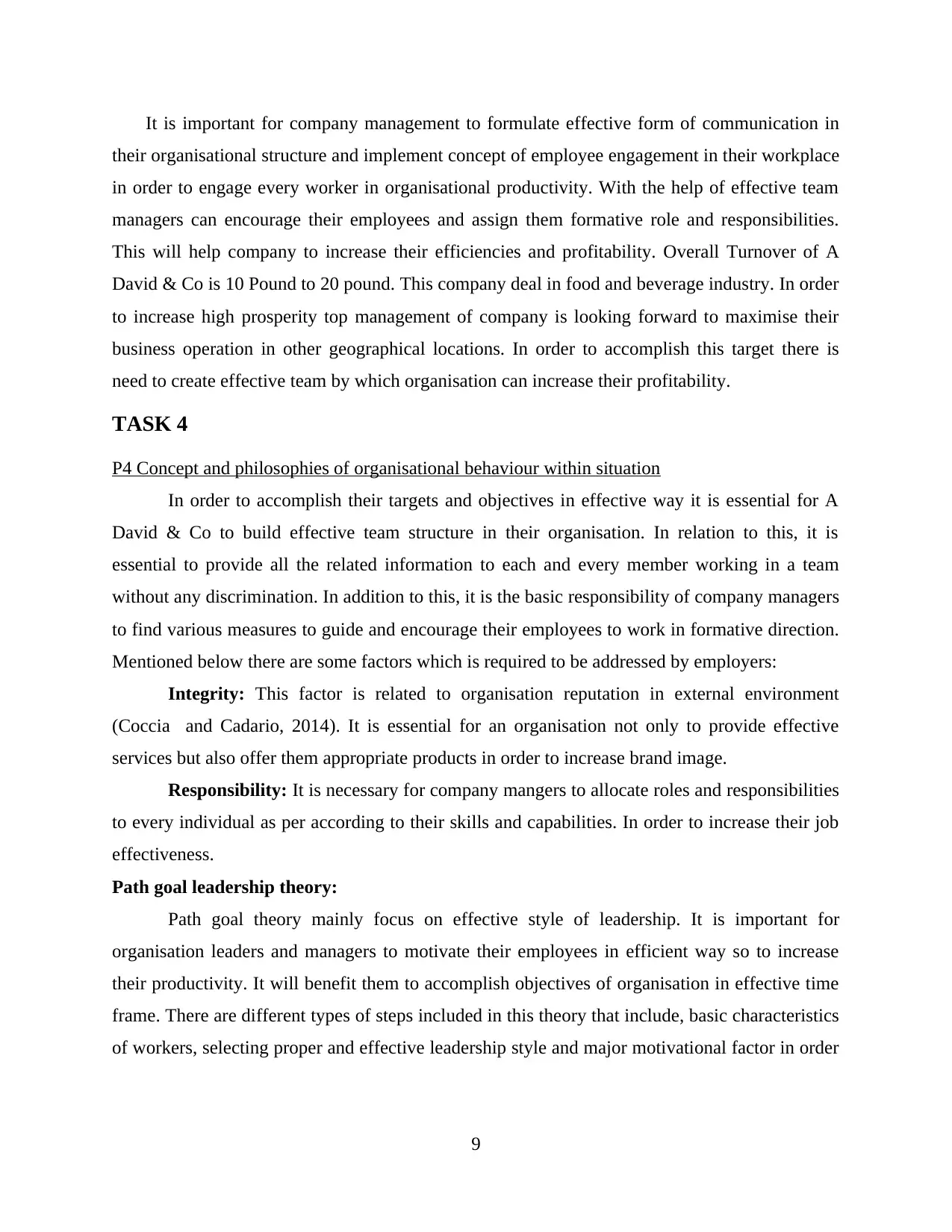
It is important for company management to formulate effective form of communication in
their organisational structure and implement concept of employee engagement in their workplace
in order to engage every worker in organisational productivity. With the help of effective team
managers can encourage their employees and assign them formative role and responsibilities.
This will help company to increase their efficiencies and profitability. Overall Turnover of A
David & Co is 10 Pound to 20 pound. This company deal in food and beverage industry. In order
to increase high prosperity top management of company is looking forward to maximise their
business operation in other geographical locations. In order to accomplish this target there is
need to create effective team by which organisation can increase their profitability.
TASK 4
P4 Concept and philosophies of organisational behaviour within situation
In order to accomplish their targets and objectives in effective way it is essential for A
David & Co to build effective team structure in their organisation. In relation to this, it is
essential to provide all the related information to each and every member working in a team
without any discrimination. In addition to this, it is the basic responsibility of company managers
to find various measures to guide and encourage their employees to work in formative direction.
Mentioned below there are some factors which is required to be addressed by employers:
Integrity: This factor is related to organisation reputation in external environment
(Coccia and Cadario, 2014). It is essential for an organisation not only to provide effective
services but also offer them appropriate products in order to increase brand image.
Responsibility: It is necessary for company mangers to allocate roles and responsibilities
to every individual as per according to their skills and capabilities. In order to increase their job
effectiveness.
Path goal leadership theory:
Path goal theory mainly focus on effective style of leadership. It is important for
organisation leaders and managers to motivate their employees in efficient way so to increase
their productivity. It will benefit them to accomplish objectives of organisation in effective time
frame. There are different types of steps included in this theory that include, basic characteristics
of workers, selecting proper and effective leadership style and major motivational factor in order
9
their organisational structure and implement concept of employee engagement in their workplace
in order to engage every worker in organisational productivity. With the help of effective team
managers can encourage their employees and assign them formative role and responsibilities.
This will help company to increase their efficiencies and profitability. Overall Turnover of A
David & Co is 10 Pound to 20 pound. This company deal in food and beverage industry. In order
to increase high prosperity top management of company is looking forward to maximise their
business operation in other geographical locations. In order to accomplish this target there is
need to create effective team by which organisation can increase their profitability.
TASK 4
P4 Concept and philosophies of organisational behaviour within situation
In order to accomplish their targets and objectives in effective way it is essential for A
David & Co to build effective team structure in their organisation. In relation to this, it is
essential to provide all the related information to each and every member working in a team
without any discrimination. In addition to this, it is the basic responsibility of company managers
to find various measures to guide and encourage their employees to work in formative direction.
Mentioned below there are some factors which is required to be addressed by employers:
Integrity: This factor is related to organisation reputation in external environment
(Coccia and Cadario, 2014). It is essential for an organisation not only to provide effective
services but also offer them appropriate products in order to increase brand image.
Responsibility: It is necessary for company mangers to allocate roles and responsibilities
to every individual as per according to their skills and capabilities. In order to increase their job
effectiveness.
Path goal leadership theory:
Path goal theory mainly focus on effective style of leadership. It is important for
organisation leaders and managers to motivate their employees in efficient way so to increase
their productivity. It will benefit them to accomplish objectives of organisation in effective time
frame. There are different types of steps included in this theory that include, basic characteristics
of workers, selecting proper and effective leadership style and major motivational factor in order
9
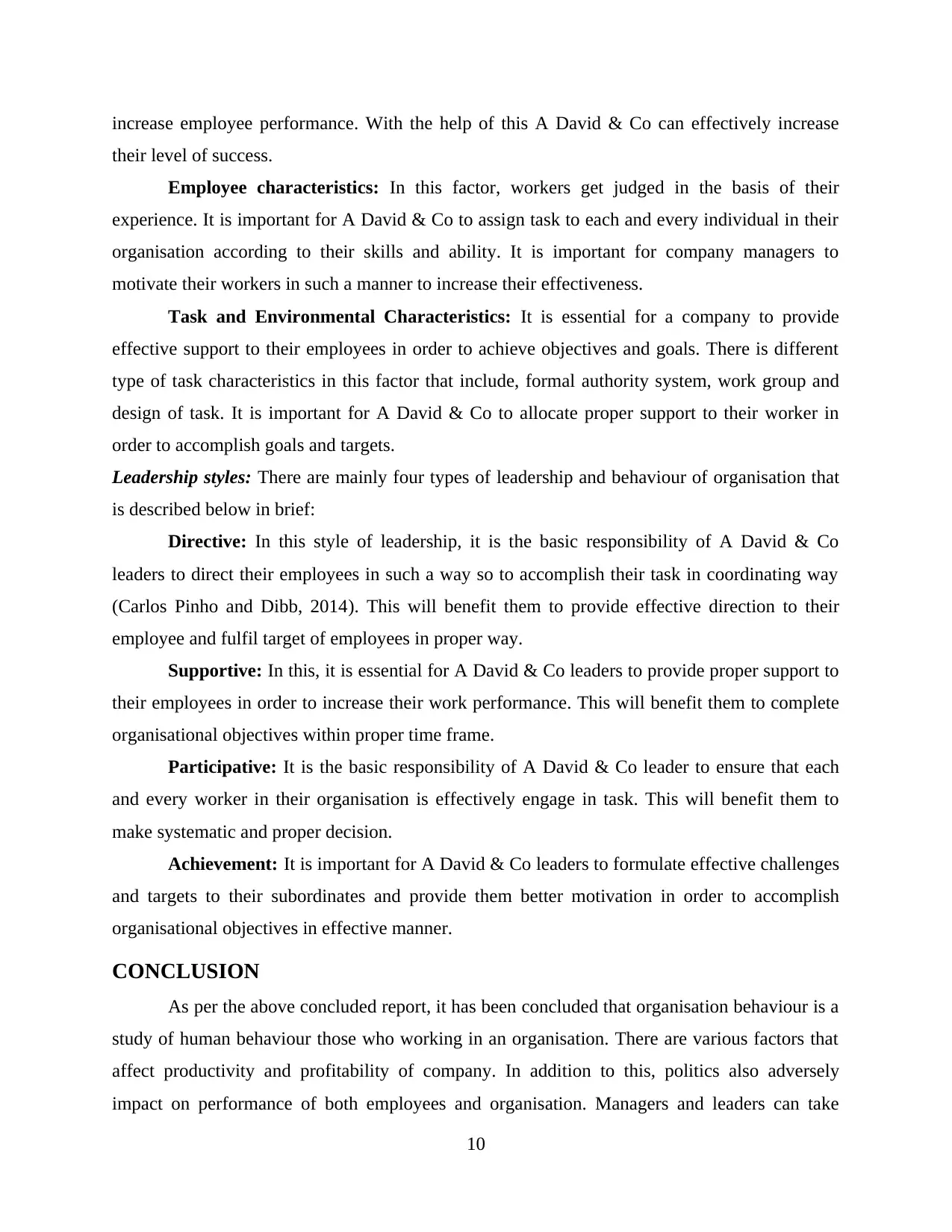
increase employee performance. With the help of this A David & Co can effectively increase
their level of success.
Employee characteristics: In this factor, workers get judged in the basis of their
experience. It is important for A David & Co to assign task to each and every individual in their
organisation according to their skills and ability. It is important for company managers to
motivate their workers in such a manner to increase their effectiveness.
Task and Environmental Characteristics: It is essential for a company to provide
effective support to their employees in order to achieve objectives and goals. There is different
type of task characteristics in this factor that include, formal authority system, work group and
design of task. It is important for A David & Co to allocate proper support to their worker in
order to accomplish goals and targets.
Leadership styles: There are mainly four types of leadership and behaviour of organisation that
is described below in brief:
Directive: In this style of leadership, it is the basic responsibility of A David & Co
leaders to direct their employees in such a way so to accomplish their task in coordinating way
(Carlos Pinho and Dibb, 2014). This will benefit them to provide effective direction to their
employee and fulfil target of employees in proper way.
Supportive: In this, it is essential for A David & Co leaders to provide proper support to
their employees in order to increase their work performance. This will benefit them to complete
organisational objectives within proper time frame.
Participative: It is the basic responsibility of A David & Co leader to ensure that each
and every worker in their organisation is effectively engage in task. This will benefit them to
make systematic and proper decision.
Achievement: It is important for A David & Co leaders to formulate effective challenges
and targets to their subordinates and provide them better motivation in order to accomplish
organisational objectives in effective manner.
CONCLUSION
As per the above concluded report, it has been concluded that organisation behaviour is a
study of human behaviour those who working in an organisation. There are various factors that
affect productivity and profitability of company. In addition to this, politics also adversely
impact on performance of both employees and organisation. Managers and leaders can take
10
their level of success.
Employee characteristics: In this factor, workers get judged in the basis of their
experience. It is important for A David & Co to assign task to each and every individual in their
organisation according to their skills and ability. It is important for company managers to
motivate their workers in such a manner to increase their effectiveness.
Task and Environmental Characteristics: It is essential for a company to provide
effective support to their employees in order to achieve objectives and goals. There is different
type of task characteristics in this factor that include, formal authority system, work group and
design of task. It is important for A David & Co to allocate proper support to their worker in
order to accomplish goals and targets.
Leadership styles: There are mainly four types of leadership and behaviour of organisation that
is described below in brief:
Directive: In this style of leadership, it is the basic responsibility of A David & Co
leaders to direct their employees in such a way so to accomplish their task in coordinating way
(Carlos Pinho and Dibb, 2014). This will benefit them to provide effective direction to their
employee and fulfil target of employees in proper way.
Supportive: In this, it is essential for A David & Co leaders to provide proper support to
their employees in order to increase their work performance. This will benefit them to complete
organisational objectives within proper time frame.
Participative: It is the basic responsibility of A David & Co leader to ensure that each
and every worker in their organisation is effectively engage in task. This will benefit them to
make systematic and proper decision.
Achievement: It is important for A David & Co leaders to formulate effective challenges
and targets to their subordinates and provide them better motivation in order to accomplish
organisational objectives in effective manner.
CONCLUSION
As per the above concluded report, it has been concluded that organisation behaviour is a
study of human behaviour those who working in an organisation. There are various factors that
affect productivity and profitability of company. In addition to this, politics also adversely
impact on performance of both employees and organisation. Managers and leaders can take
10
⊘ This is a preview!⊘
Do you want full access?
Subscribe today to unlock all pages.

Trusted by 1+ million students worldwide
1 out of 15
Related Documents
Your All-in-One AI-Powered Toolkit for Academic Success.
+13062052269
info@desklib.com
Available 24*7 on WhatsApp / Email
![[object Object]](/_next/static/media/star-bottom.7253800d.svg)
Unlock your academic potential
Copyright © 2020–2025 A2Z Services. All Rights Reserved. Developed and managed by ZUCOL.





